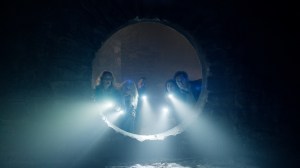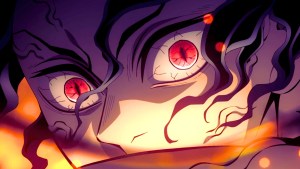
It’s now official that Scott Snyder and Greg Capullo are both departing Batman after more than forty issues on the series beginning with its New 52 relaunch. Their collaboration has established them as a permanent part of the conversation when it comes to definitive takes on Batman alongside comics luminaries like Frank Miller, Dennis O’Neill, and Neal Adams. Almost every story in their run has created an epic scope and aimed at making a statement about who Batman is. They are a creative team (along with other contributors like inker Danny Miki and colorist FCO Plascencia) that always swung for the fences and knocked quite a few issues out of the park, making modern day superhero masterpieces. Yet it wasn’t until Batman #49 that Snyder appeared ready to craft a thesis statement for his take on the character. While it may be part of the incomplete “Superheavy” story, Batman #49 stands alone as a powerful statement on who the Dark Knight is.
Videos by ComicBook.com
Before looking at Batman #49 it’s significant to reexamine the stories that preceded it, specifically the second part of Snyder and Capullo’s origin epic “Zero Year” the appropriately titled “Dark City”. It’s here that Batman continues to pursue the Riddler’s machinations by himself rejecting the help of future allies like Commissioner Gordon and Alfred Pennyworth. As he continues to push himself forward and his potential friends away, Pennyworth stops Bruce to confront him about the true nature of his task.

The most significant parts of Pennyworth’s extended speech to Batman in Batman #27 focus on two points: 1) that Bruce Wayne has become something else and 2) he is still transfixed by the emotions he felt on the night of his parent’s murder. In this specific instance Pennyworth is scared that Wayne’s loneliness and anger after being left alone and helpless are causing him to push others away. It’s a fair judgement that is visually driven home at the conclusion of “Dark City” in Batman #29. In the final moments of the issue Batman witnesses Gotham being plunged into darkness as he fails the city, and his feelings of terror and anger are juxtaposed with the same expressions as he witnessed the death of his parents. The final panel of the issue is an image of a young crying Bruce Wayne screaming “Help!” revealing that even as a strong, grown man his internal state remains fixed to that moment of childhood.
“Zero Year” is a story primarily focused on the multiple ways in which Batman fulfilled his potential, utilizing each section to tackle different conceits. Batman #49 boils down this extended origin and the other adventures crafted by Snyder and Capullo that surround it into a single statement though. It is an issue that takes past, present, and future to point out the most necessary element of Batman: tragedy.
In the issues of “Superheavy” leading to Batman #49, Bruce Wayne has been reborn as a man innocent of his parent’s deaths. He is intellectually aware of what has happened, but has not experienced the horror of the moment. Instead, he has been left with his physical and mental acuteness, but none of the scarring. That has allowed him to become an influential philanthropist and of finding love with Julie Madison; he is living a happy, fulfilling life. However, things have not gone well in Gotham City and his replacement (Gordon equipped with a powersuit) has been unable to stop a new supervillain. So after having become aware of his previous life as Batman, Bruce has determined he must resume that role in order to protect Gotham.

Batman #49, drawn and colored by guest artists Yanick Paquette and Nathan Fairbairn, shows Bruce confronting Pennyworth about the facts of his life. Eventually, Pennyworth relents and shows Bruce to the Batcave and the machine Batman designed to restore his mind to a cloned body (first shown in the anniversary celebration of Detective Comics #27, drawn by Sean Murphy).
At first Bruce supposes that the machine could “make something new. A Batman without the trauma, something greater than he ever was before.” Things are not that simple though. It becomes apparent that it is impossible to combine the consciousness of Batman with the consciousness of this reborn Bruce Wayne. He is rocked by the machine as it threatens to fracture his mind each time it fails. After two attempts it becomes apparent that it is impossible to combine this well adjusted version of Bruce Wayne and Batman, it is a choice between one or the other.
It’s important to note this is Snyder’s choice, a thematically-driven element of pseudoscience. This is not simply a matter of returning the status quo of Batman after the character’s “death in Batman #40; it is a forced choice and a purposeful statement regarding who this person is. Snyder is explicitly stating that Batman and Bruce Wayne cannot exist, that trauma is a necessary component of who this hero is.
After Bruce Wayne recognizes this as a fact, he asks Pennyworth to instigate brain death, effectively killing him and allowing the Batman personality to assume his form. It is essentially the only murder Batman is capable of committing, the taking of his own life. Bruce’s noble suicide not only removes himself from existence, but returns the murder of his parents as its sole witness is resurrected. It is a terrible sacrifice and a moment of truly noble heroism. Bruce’s singular act does not belong solely to him, it is the Batman’s as well. Where Bruce chose to become the Batman once more, Batman must live with the consequences of this choice as he commits himself to it again every day.

In the moment of his simultaneous death and rebirth, Bruce and Batman are fixed on their knees, arms outstretched, and face cast upward at a glowing, godlike source of light. They are both a servant submitting to prayer and a martyr placed on an unseen cross. This moment of brain death as Bruce Wayne become Batman is fixed in time, framed by a bat-shaped panel, a last moment of innocence. The choice between these two identities and the necessary death of the former, both as a child in Crime Alley and now a man in the Batcave, reveals that the Batman can never be innocent or unharmed. The existence of Batman is based in the trauma of an irreversible crime, and that trauma cannot be removed as long as Batman continues to exist.
Superhero comics dance strangely between comedy and tragedy, their unending variations refusing to provide the pathos of the latter, while their unrelenting conflict denies any conception of a happy ending. Snyder has crafted a statement in which the lack of conclusion forms the basis for Batman’s tragedy. His very existence is worthy of mourning for he can only exist as the same terrified, angry, despairing orphan shown in the final page of Batman #29.
Snyder and Paquette do not limit Batman’s continuation to the current issue either. They reveal the endless cycle of Batmen doomed to be continually created by this machine in circular panels that float through issue. Different costumes and tragic ends meet a seemingly endless variation of possible futures, which Bruce must witness each time Batman’s consciousness is crashed into his own. The endless tragedy of Batman is not only continued here, but promised to never cease.

This never ending cycle plays on the central conceit of Snyder’s predecessor Grant Morrison. At the core of Morrison’s equally legendary run on the character, also spanning multiple series, lies the image of the ouroboros and concept of Batman as a constant figure. No matter how much changes in Batman’s life throughout Morrison’s comics, he remains, even in death. It is a concept clearly stated in Batman Inc. #13 and visually repeated in Batman #49:
“Batman always comes back, bigger and better, shiny and new. Batman never dies. It never ends. It probably never will.”
Even though Morrison also incorporated the camp and fun of Silver Age Batman, artist Chris Burnham concludes this statement with a fearsome, spectre-like vision of Batman charging the reader. In this regard Morrison and Snyder mirror one another’s vision of the iconic character. Despite the fun and love to be found in his many appearances, Batman is at his center a tragic figure. His very existence is a curse based on the horrific murder of two loving parents in front of the eyes of their only child. Batman’s heroism is derived from this tragedy and even his greatest triumphs must be viewed as a consequence of this single moment.
It is a striking, powerful thesis of who the Batman is beautifully told by Snyder, Paquette, and Fairbairn in Batman #49, marking it as one of the best Batman stories ever told.








